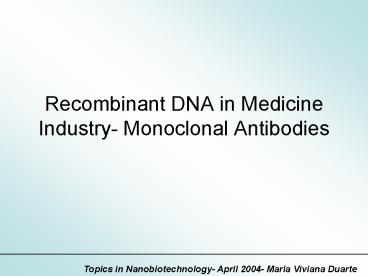Recombinant DNA in Medicine Industry- Monoclonal Antibodies - PowerPoint PPT Presentation
1 / 16
Title:
Recombinant DNA in Medicine Industry- Monoclonal Antibodies
Description:
Recombinant DNA in Medicine Industry- Monoclonal Antibodies Topics in Nanobiotechnology- April 2004- Maria Viviana Duarte – PowerPoint PPT presentation
Number of Views:489
Avg rating:3.0/5.0
Title: Recombinant DNA in Medicine Industry- Monoclonal Antibodies
1
Recombinant DNA in Medicine Industry- Monoclonal
Antibodies
Topics in Nanobiotechnology- April 2004- Maria
Viviana Duarte
2
Introduction
As soon as first successful cloning experiments
were reported in 1973, applications for this
powerful technology quickly followed- Proteins
were produced through recombinant DNA technology
for
- Somatostatin (1976)- 14 aminoacids peptide
neurtransmitter - Treatment of numerous diseases
- Insulin for the treatment of diabetes
- Human Growth Hormone
- Food Production
- MAb development
- etc
Topics in Nanobiotechnology- April 2004- Maria
Viviana Duarte
3
Expression Systems are developed to Produce
Recombinant Proteins
Cloning the gene or cDNA encoding a particular
proteins is only the first of many steps needed
to produce a recombinant protein
Next step put he gene into a host cell for
production
Topics in Nanobiotechnology- April 2004- Maria
Viviana Duarte
4
Expression Systems
Expression system Positive Negative
Bacterial cells (B. subtilis) Simplicity Short generation times Large yields of product Can be induced to secrete the product into the culture medium Ej Bacterial production of human growth hormone (hGH) Although some proteins are expressed to high levels, they often the fail to fold properly and form insoluble inclusion bodies Foreign proteins are sometimes toxic to bacteria Lack enzymes that are present in eukaryotic cells and add posttranslational modifications (phosphates, sugars)
Yeast Simple eukaryote that resembles mammalian cells in may ways but can be grown as quickly and cheaply as bacteria can Can be induced to secrete the product into the culture medium Perform posttranslational modifications Active proteases that degrade foreign proteins (reducing yield of product)
Insects cell by baculovirus vectors High level expression Correct folding Posttranslational modifications Ej Vaccine for the AIDS virus has been prepared by producing on of the HIV glycoproteins with this system Higher costs than bacteria and yeast, but lower than mammal cells
Mammalian cells Checking the function of a newly cloned gene and as a quick methods for assessing the function of engineered proteins. Ej large scale production for proteins such as tissue plasmoninogen activator Cost Still in development
The choice of which cell is used dependes on the
project goal and on the properties of the protein
to be produced
Topics in Nanobiotechnology- April 2004- Maria
Viviana Duarte
5
Monoclonal Antibodies Function
- Antibodies are exquisitely selective proteins
that can bind to a single target among millions
of irrelevant sites - Could effectively seek and destroy tumor cells
and infectious agents wherever the reside
Producing a useful antibody in large quantities
Topics in Nanobiotechnology- April 2004- Maria
Viviana Duarte
6
Researchers tested myelomas
Lack to produce an antibody to their
specifications
Hybridoma- produce antibodies specified by the
lymphocyte from the immunized animal
- Monoclonal antibodies are already widely used for
the diagnostic of infections and cancer and for
the imaging of tumors for radiotherapy - Preparing specfic antibodies abzyme- antibodies
with catalytic activity, birecognition, etc
Topics in Nanobiotechnology- April 2004- Maria
Viviana Duarte
7
Hybridoma
Recombinant DNA- Watson, Gilman, Witkowski,
Zoller. Scientific American Books. 1992
Topics in Nanobiotechnology- April 2004- Maria
Viviana Duarte
8
Bypassing fusion step
Direct cloning antibody cDNAs from the
lymphocytes of immunized mice
Recombinant DNA- Watson, Gilman, Witkowski,
Zoller. Scientific American Books. 1992
Topics in Nanobiotechnology- April 2004- Maria
Viviana Duarte
9
More Monoclonal antibodyes
- Humanized MAb
- Bispecific antibodies
- Effector Domains modification
Topics in Nanobiotechnology- April 2004- Maria
Viviana Duarte
10
More Monoclonal antibodyes- Humanized
Humanized monoclonal antibodies
Topics in Nanobiotechnology- April 2004- Maria
Viviana Duarte
11
Humanized monoclonal antibodies
The variable regions differ in sequence from on
antiblody to another, this is the region of the
protein that binds the antigen
How to humanized the MAb?
Not fully humanized
Recombinant DNA- Watson, Gilman, Witkowski,
Zoller. Scientific American Books. 1992
Topics in Nanobiotechnology- April 2004- Maria
Viviana Duarte
12
Humanized monoclonal antibodies
Humanized MAb in clinical trials as an
immunosuppressant and for treatment of lymphoid
tumors.
Topics in Nanobiotechnology- April 2004- Maria
Viviana Duarte
13
Humanized monoclonal antibodies
Review article Supported by a grant from Zeneca
Pharmaceuticals Humanized antibodies as
potential therapeutic drugs Surender K Vaswani,
MD and Robert G Hamilton, PhD
Topics in Nanobiotechnology- April 2004- Maria
Viviana Duarte
14
Humanized monoclonal antibodies
Topics in Nanobiotechnology- April 2004- Maria
Viviana Duarte
15
Bispecific antibodies
Bispecific antibodies in cancer therapy.Segal
DM, Weiner GJ, Weiner LM.Immune Targeting
Section, Experimental Immunology Branch, National
Cancer Institute, Building 10 Room 4B36, National
Institutes of Health, Bethesda, MD 20892-1360,
USA. dave_segal_at_nih.govBased upon in vitro and
animal studies, a number of Phase I and II
clinical trials have been initiated to test
whether bispecific antibodies could redirect
immune effectors against tumor cells in cancer
patients. Recently, results from those trials
showed beneficial effects in some patients but it
is clear many problems remain to be solved. In
addition, molecular engineering approaches are
providing new and improved sources of clinically
relevant bispecific antibodies.
http//users.telenet.be/nmertens/U11/IM_bispecific
_antibodies.htm
Topics in Nanobiotechnology- April 2004- Maria
Viviana Duarte
16
Thanks for your attention
Topics in Nanobiotechnology- April 2004- Maria
Viviana Duarte































